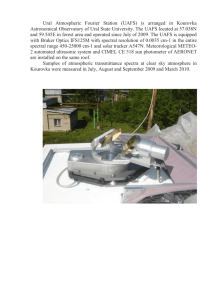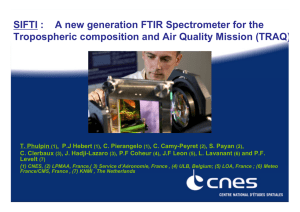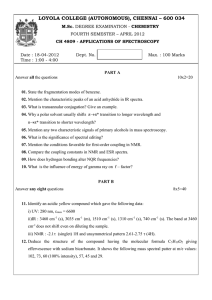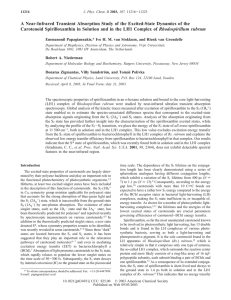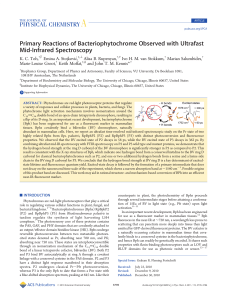Russian Meteorological Satellite Systems Presented at ITSC-19, March 2014 SRC PLANETA, Roshydromet
advertisement
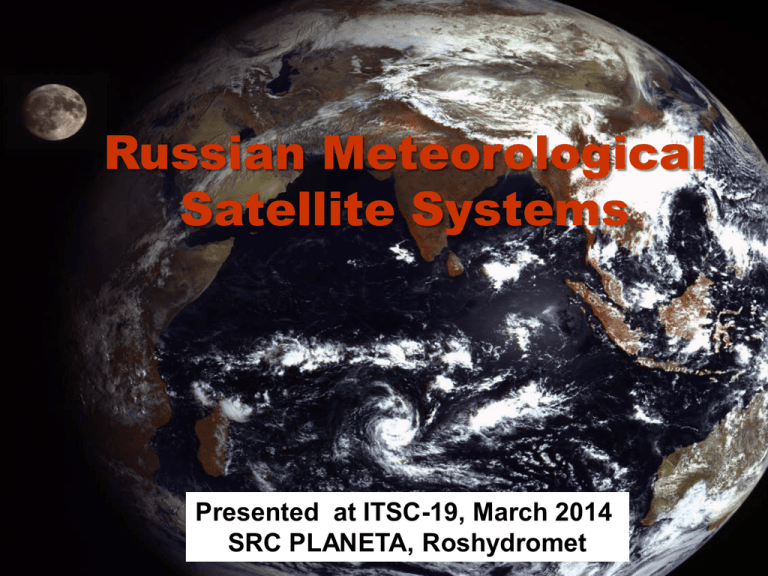
Russian Meteorological Satellite Systems Presented at ITSC-19, March 2014 SRC PLANETA, Roshydromet Planning of Russian Meteorological Satellite Systems 2009 2010 2011 2012 2013 2014 2015 2016 2017 2018 2019 2020 ELECTRO № 1 (76°E)– launched on January 20, 2010 ELECTRO № 2 (77.8° E) ELECTRO № 3 (TBD) ARCTICA-M № 1 ARCTICA-M № 2 METEOR-М № 1 – launched on September 17, 2009 METEOR-М № 2 METEOR-М № 2-1 METEOR-М № 2-2 METEOR-М № 3 Oceanographic METEOR-МP Experimental METEOR-МP № 1 2021 2022 METEOR-M General Design In-orbit mass – Payload mass – Lifetime – Russian meteorological satellite Meteor-М №1 was launched on September, 17th 2009 2700 kg 1200 kg 5 years Orbit – Sun-synchronous Altitude – 830 km Data dissemination format – HRPT/LRPT Meteor-M № 2, 2-1, 2-2 Basic Instruments Specifications Instrument Application MSU-MR Low-resolution multi-channel scanning unit Global and regional cloud cover mapping, ice and snow cover observation, forest fire monitoring, … KMSS Visible spectrum scanning imager Spectral band Swath- Resolution (km) width (km) 0,5 – 12,5µm (6 channels) 3000 Earth surface monitoring for various tasks (floods, soil and vegetation cover state, ice cover) 0,4-0,9 µm (3+3 channels) 450/900 MTVZA-GY Imager-sounder (module for temperature and humidity sounding of the atmosphere) Atmospheric temperature and humidity profiles, sea surface wind 10,6-183,3 GHz (26 channels) 2600 12 – 75 IRFS-2 Advanced IR sounder (infrared Fourierspectrometer) Atmospheric temperature and humidity profiles 5-15 µm 2000 35 “Severjanin-M” Synthetic aperture radar All-weather Ice coverage monitoring 9500-9700 MHz 600 0,4 x 0,5 GGAK-M Heliogeophysical instrument suite Heliogeophysical data providing BRK SSPD Data Collection System Data retransmission from DCP 1x1 0,05/0,1 IRFS-2 Basic Performance Characteristics Parameter Units Value Spectral range: wavelength wave number µm cm-1 5-15 2000-665 Reference channel wavelength µm 1.06 Maximum optical path difference (OPD) mm 17 Angular size of FOV mrad 40 x 40 Spatial resolution (at sub-satellite point) km 35 Swath Width and spatial sampling km 2500, 110 2000, 100 s 0.5 Duration of the interferogram measurement 216 Dynamic range Mass kg 45-50 Power W 50 Spectral region Absorption band 665 to 780 cm-1 CO2 790 to 980 cm-1 Atmospheric window 1000 to 1070 cm-1 O3 1080 to 1150 cm-1 Atmospheric window 1210 to 1650 cm-1 H2O, N2O, CH4 Application Temperature profile Surface parameters (Ts, εν), cloud properties Ozone sounding Ts, εν,; cloud properties Moisture profile, CH4, N2O, column amounts Spectral resolution, cm-1 , in region 650-1000 cm-1 IASI 0.35 CrIS 0.625 IRFS 0.5 This figure was based on a figure from: W. Smith, E. Weisz, et al Weather and Climate Applicatons of Ultraspectral IR Radiance Measurements, IRS 2012, 06-10 August 2012, Dahlem Cube, Berlin Germany
